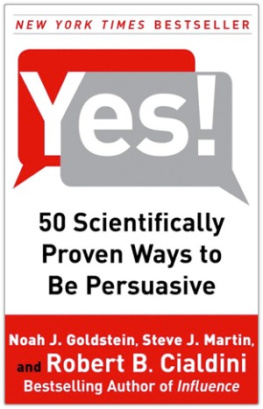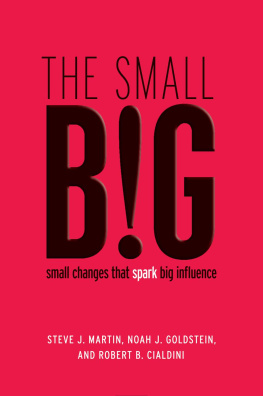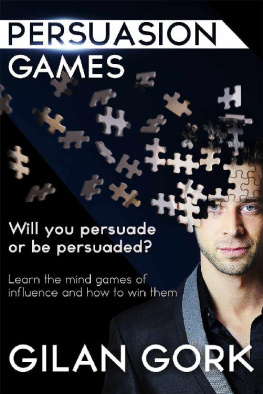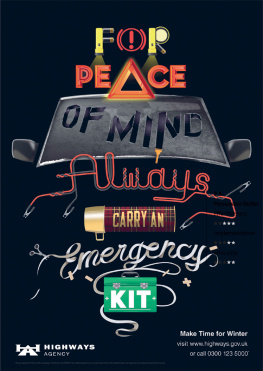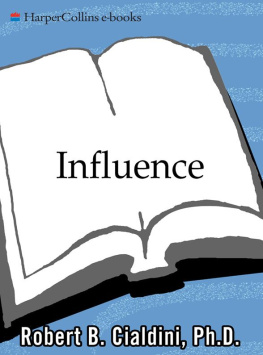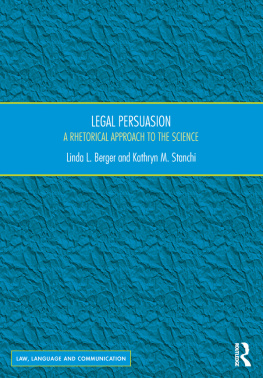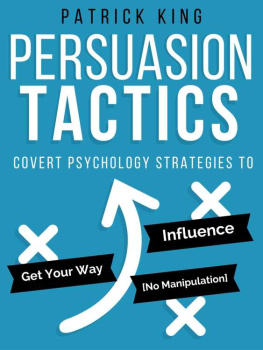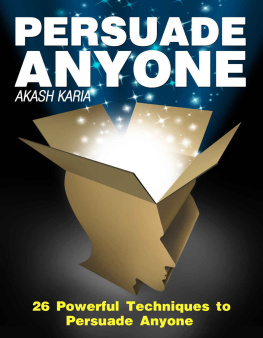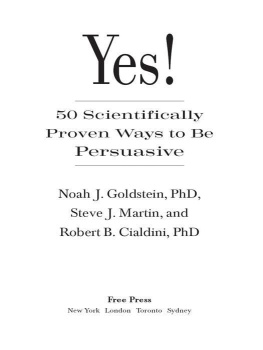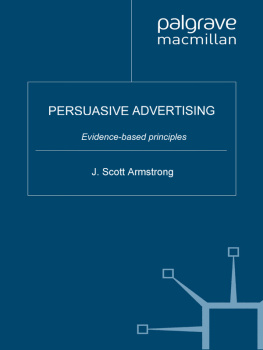


FREE PRESS
A Division of Simon & Schuster, Inc.
1230 Avenue of the Americas
New York, NY 10020
Copyright 2008 by Noah J. Goldstein, Steve J. Martin,
and Robert B. Cialdini
All rights reserved, including the right to reproduce this book
or portions thereof in any form whatsoever. For information address
Free Press Subsidiary Rights Department, 1230 Avenue of
the Americas, New York, NY 10020
FREE PRESS and colophon are
trademarks of Simon & Schuster, Inc.
Library of Congress Cataloging-in-Publication Data
Goldstein, Noah J.
Yes!: 50 scientifically proven ways to be persuasive/
Noah J. Goldstein,
Steve J. Martin, and Robert B. Cialdini.
p. cm.
Includes bibliographical references and index.
1. Business communication. 2. Persuasion (Psychology).
3. Marketing. 4. Interpersonal communication. I. Martin, Steve J. II. Cialdini, Robert B. III. Title.
HF5718.G65 2008
658. 4'5dc22 2007041917
ISBN-13: 978-1-4165-7112-4
ISBN-10: 1-4165-7112-4
Visit us on the World Wide Web:
http://www.SimonSays.com
For my parents and, of course, for JenessaNJG
For my niece and nephew Casie Leigh and RileySJM
For my granddaughter Hailey Brooke CialdiniRBC
Preface
A ccording to John Lennon, the moment he first began falling in love with Yoko Ono occurred at an installation of her work at a London art gallery in 1966. One piece in the exhibition required viewers to climb to the top of a dimly lit, shaky ladder and then to peer through a spyglass into a small area of the ceiling, where a single word was displayed in barely perceptible letters.
The word was small and simple. But it struck Lennon with so much force that, although he didnt fall physically from the ladder, he began to fall emotionally for the woman who had arranged for him to see that word under those conditionsbecause he immediately resonated with her recognition of its healing power in a darkly dangerous, ominously unstable world.
That word was not love, as most people think. Instead, it was a word that both leads to and flows from love and, fortunately, is much more obtainable.
The word was yes.
Just because yes is simple and obtainable, we shouldnt be fooled into believing that anyone can easily secure it from othersat least not without knowing certain secrets of the persuasion process. The primary purpose of this book is to give readers access to fifty secrets to successful persuasion that have been validated in scientific studies and that can be used in wholly ethical ways. Even though, as the books authors, we wouldnt try to turn John Lennons famous lyric into the claim All you need is Yes!, we are confident that readers who understand and properly employ the books lessons will become markedly more persuasive at work, at home, and elsewhere.
Introduction
T heres an old joke told by the nightclub comic Henny Youngman, who referred to his accommodations from the previous night by saying, What a hotel! The towels were so big and fluffy I could hardly close my suitcase.
Over the last few years, the moral dilemma facing hotel guests has changed. These days, the question of whether to remove the towels from their room has been replaced by the question of whether to reuse the towels during the course of their stay. With the increasing adoption of environmental programs by hotels, more and more travelers are being asked to reuse their towels to help conserve environmental resources, save energy, and reduce the amount of detergent-related pollutants released into the environment. In most cases, this request comes in the form of cards placed in guests bathroomscards that provide some surprising insights into the remarkable science of persuasion.
A survey of the persuasive messages conveyed by dozens of request cards from a wide variety of hotels around the globe reveals that these cards most commonly attempt to encourage towel recycling efforts by focusing guests almost exclusively on the importance of environmental protection. In other words, guests are almost invariably informed that reusing their towels will conserve natural resources and help spare the environment from further depletion, disruption, and corruption. To further draw guests attention to the impact of towel recycling on the environment, this information is often accompanied by various eye-catching, environment-related pictures in the background, ranging from rainbows to raindrops to rainforeststo reindeer.
This persuasion strategy generally seems to be an effective one. For example, one of the largest manufacturers of these signs, whose messages focus entirely on the importance of environmental protection, reports that the majority of hotel guests who have the opportunity to participate in these programs do reuse their towels at least once during their stay. But could the results be improved?
Researchers are often on the lookout for ways to apply their scientific knowledge to make existing policies and practices even more effective. Much like a highway billboard that reads, Place your ad here, these little towel recycling cards spoke to us, practically pleaded with us, to Test your ideas here. So we did. And in doing so, we showed that just by making a small change to the way in which the request is made, hotel chains can do much, much better.
As this book will reveal, starting with our towel experiments, small, easy changes to our messages and to our requests can make them vastly more persuasive. In fact, were going to claim that everyones ability to persuade others can be improved by learning persuasion strategies that have been scientifically proven to be successful. We will report on dozens of studies, some conducted by us, some by other scientists, that demonstrate this point in many different settings. Along the way, we will discuss the principles behind these findings. The central purpose of this book is to provide the reader with a better understanding of the psychological processes underlying our efforts to influence others to shift their attitudes or behavior in a direction that results in positive outcomes for both parties. In addition to presenting a variety of effective and ethical persuasion strategies, we also discuss the types of things to watch out for to help you resist both subtle and overt influences on your decision-making.
The studies discussed in this book are scientifically rigorous, but they can also be fun. For example, well seek to provide insights about what single office supply can make your attempts to persuade others significantly more effective, what Luke Skywalker can teach us about being an influential leader, why people named Dennis are disproportionately more likely to become dentists, how slipping your audience the perfectly legal drug 1,3,7-trimethylxanthin can help you become more persuasive, how inconveniencing your rivals will make them more likely to do favors for you, and why people would be more likely to buy a BMW just after giving reasons for preferring a Mercedes.
Well also seek to answer a number of other important questions. For example: What common mistake do communicators often make that causes their message to backfire? Which one word will strengthen your persuasion attempts? Is it better to start low or high when selling items on eBay? How can you turn your weaknesses into persuasive strengths? How can waiters increase their tips without changing the quality of their service? And why can sometimes seeing yourselfor being seen by othersas an expert result in one of the most dangerous situations in which you could ever be placed?

